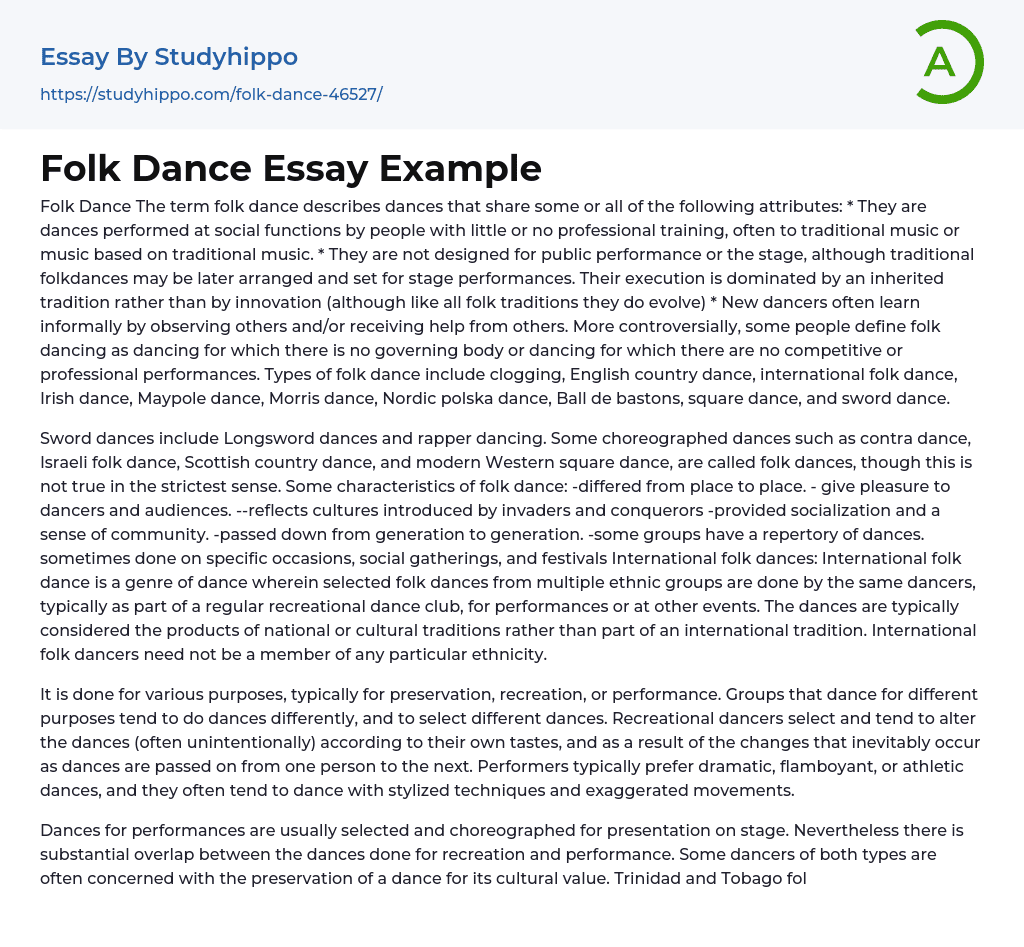Folk Dance refers to dances performed at social functions by individuals with little or no professional training. These dances are often accompanied by traditional music or music derived from it. Although not intended for public performance or the stage, traditional folk dances can be adapted and showcased for stage presentations. Their execution is mainly influenced by inherited traditions rather than innovation, but like all folk traditions, they do evolve over time. New dancers typically learn by observing others or with the assistance of more experienced dancers. Some controversially characterize folk dancing as dance forms lacking a governing body or without competitive or professional performances. Examples of folk dances include clogging, English country dance, international folk dance, Irish dance, Maypole dance, Morris dance, Nordic polska dance, Ball de bastons, square dance, and sword dance.
Sword dance
...s, such as Longsword dances and rapper dancing, belong to the realm of folk dances. Other forms of choreographed folk dances include contra dance, Israeli folk dance, Scottish country dance, and modern Western square dance. However, it is important to acknowledge that this categorization may not be entirely accurate. Folk dance possesses distinct characteristics: it varies across regions; it brings joy to both dancers and spectators; it reflects the cultures of conquerors and invaders; it promotes socialization and a sense of community; it is passed down through generations; some groups have a repertoire of dances performed during specific occasions, social gatherings, or festivals.
International folk dances involve performers presenting selected folk dances from various ethnic groups. These performances are typically carried out by members of the same dance club on a regular basis for shows or events. The purpos
behind these dances is to represent national or cultural traditions rather than an international tradition as a whole. It should be emphasized that being part of a particular ethnic group is not necessary for individuals participating in international folk dancing.
Dancing serves various purposes, including preservation, recreation, and performance. Different groups of dancers have unique approaches to dances and select different types. Recreational dancers unconsciously alter dances based on their preferences and natural changes that happen over time. On the other hand, performers favor dramatic, flamboyant, or athletic dances that frequently incorporate stylized techniques and exaggerated movements.
The selection and choreography of stage shows usually involve both recreational and performance dances, with a significant overlap between the two. Dancers in both categories commonly prioritize preserving dances due to their cultural importance. The dance culture of Trinidad and Tobago has been influenced by various sources throughout history, including Amerindians, colonial influences, West Africa, Northern India, and different parts of Europe.
During the 1930s, 40s, and 50s, ballet was limited to a specific group. Yet, Beryl Mc Burnie and Boscoe Holder transformed this scenario by incorporating Trinidad and Tobago folk dances into performances, thereby increasing the accessibility of formal dance. Gradually, formal dance became even more widely available. In the 1970s and 80s, Astor Johnson fused traditional movements with contemporary dance styles influenced by Graham and Horton techniques.
During the 1970s, other young modern dance performers and choreographers like Carol La Chapelle and Noble Douglas gained recognition. They were trained in Trinidad and Tobago as well as abroad and rose to prominence under Astor Johnson’s Repertory Dance Theatre. They later formed their own
dance companies, where they continue their careers as teachers, choreographers, and artistic directors. In the following decades, more young dancers had the chance to pursue their dance ambitions elsewhere. Many of them chose to study at renowned institutions like Juilliard and the Ailey School in New York.
- Sonnet essays
- Concert essays
- Piano essays
- Hip Hop essays
- Music Reference essays
- Musical Instruments essays
- Mp3 essays
- Recording essays
- Music video essays
- Singing essays
- Song essays
- Tupac shakur essays
- Classical Music essays
- Opera essays
- Rock Music essays
- Blues essays
- Jazz essays
- Sonata essays
- Baroque Music essays
- Rock And Roll essays
- Ludwig Van Beethoven essays
- Michael Jackson essays
- Popular music essays
- Band essays
- Classical Concert essays
- Music Concert Report essays
- Music Awards essays
- Walk This Way essays
- Song Analysis essays
- Activity essays
- Believe essays
- Comfort Zone essays
- Dance essays
- Fashion essays
- Fishing essays
- Fitness essays
- Freedom essays
- Habits essays
- Healthy Lifestyle essays
- Hobby essays
- Hunting essays
- Interests essays
- Justification essays
- Moment essays
- Optimism essays
- Peace essays
- Perfume essays
- Shoes essays
- Shopping essays
- Silence essays




